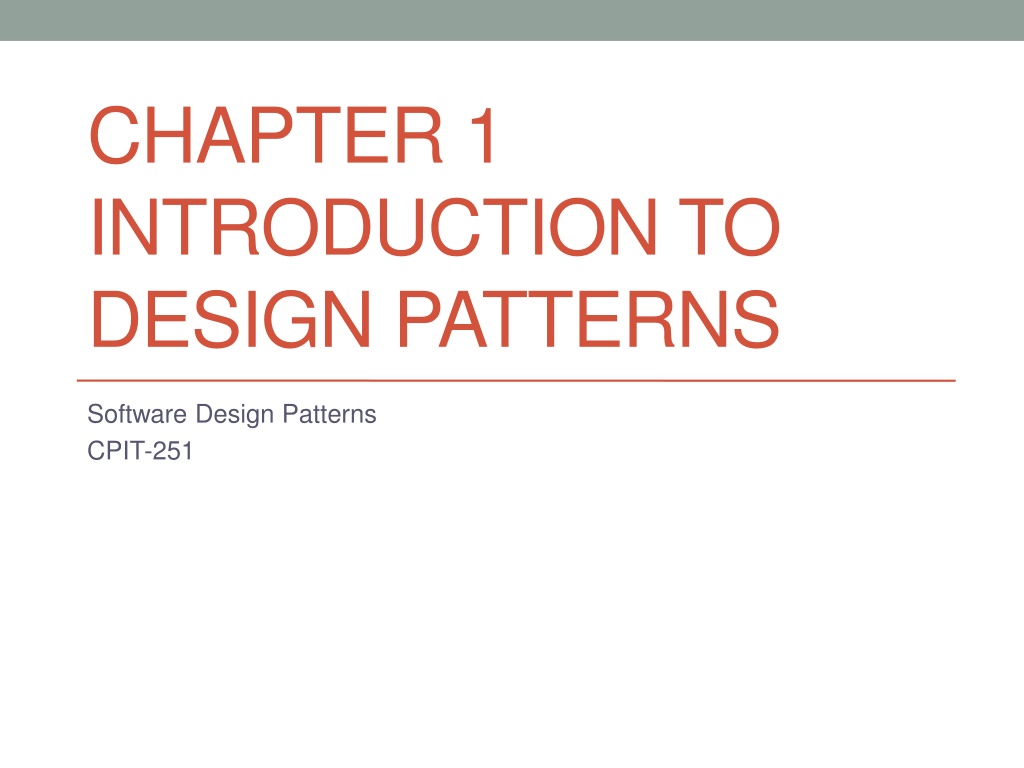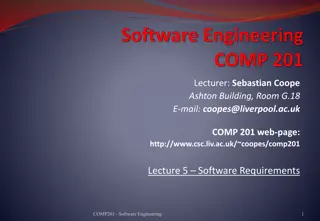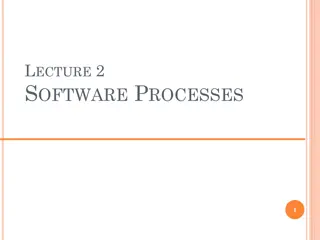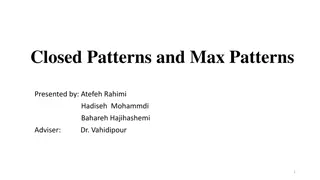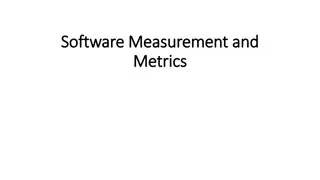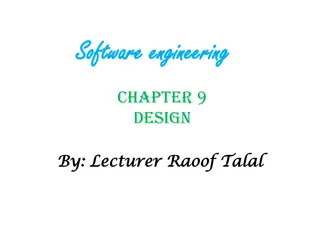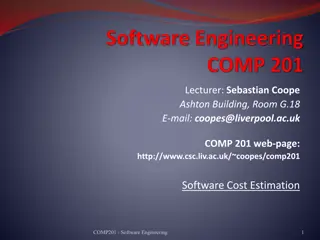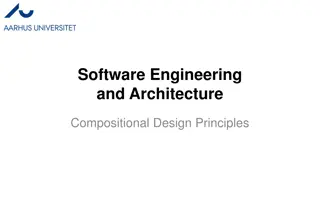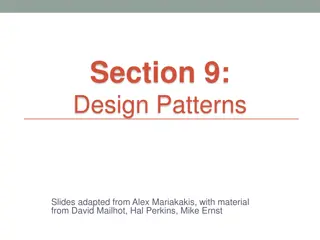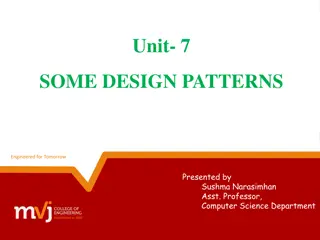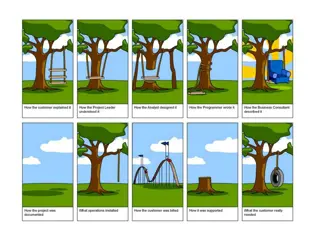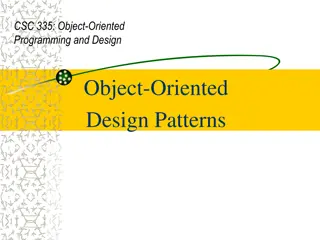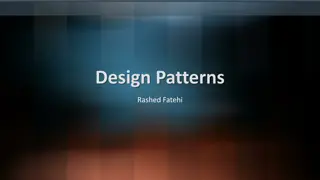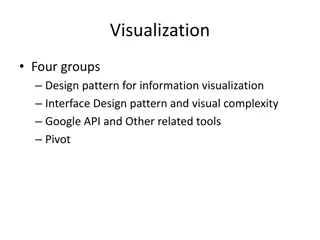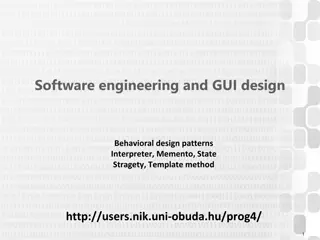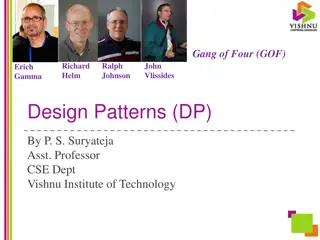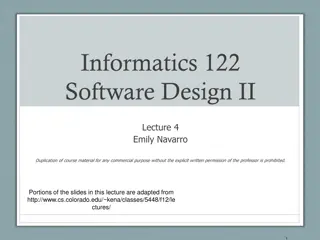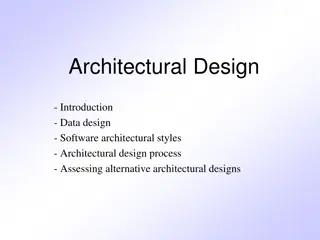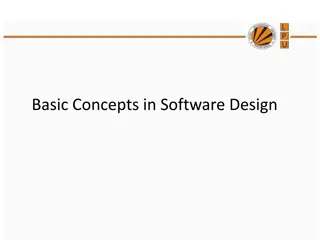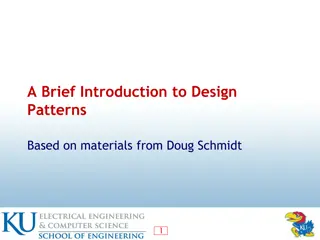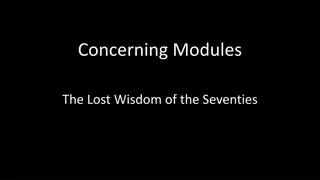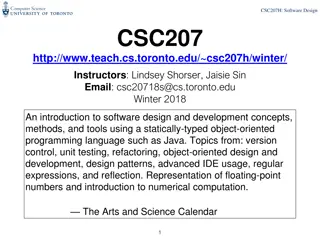Introduction to Software Design Patterns
Explore the fundamentals of software design patterns, the importance of design in software development, design techniques, and object-oriented design principles. Learn why design is crucial for creating robust and reusable software solutions.
Download Presentation

Please find below an Image/Link to download the presentation.
The content on the website is provided AS IS for your information and personal use only. It may not be sold, licensed, or shared on other websites without obtaining consent from the author.If you encounter any issues during the download, it is possible that the publisher has removed the file from their server.
You are allowed to download the files provided on this website for personal or commercial use, subject to the condition that they are used lawfully. All files are the property of their respective owners.
The content on the website is provided AS IS for your information and personal use only. It may not be sold, licensed, or shared on other websites without obtaining consent from the author.
E N D
Presentation Transcript
CHAPTER 1 INTRODUCTION TO DESIGN PATTERNS Software Design Patterns CPIT-251
What is a Design? Formulate the maximum alternative solutions of the problem and select the best one Software Design is the process of implementing a software solutions to do one or more set of problems
Why We Need A Design? Provides an overall picture of the system An understandable design is the best hope to construct a program that works Provide facilitate reuse (NOT code reuse) Design uses abstraction to create views that are comprehensible (understandable)
4 Design and Quality The design must implement all of the explicit (clear) requirements contained in the analysis model, and it must accommodate all of the implicit (hidden) requirements desired by the customer The design must be readable, understandable guide for those who generate code and for those who test and subsequently support the software The design should provide a complete picture of the software, addressing the data, functional, and behavioral domains from an implementation perspective
Design Techniques Structured/functional Design: data flow diagram (DFD), entity relation diagram (ERD), and Hierarchical Charts Object Oriented Design: UML, Use Cases and Class Diagrams Examples of Design Tools Rational Rose, Star UML, Together Soft, and Microsoft Visio
Object Oriented Design Techniques Basic components Classes, which include objects Functions Component relationships One class uses other classes to fulfill its responsibilities Methods from one class call methods in the other classes Inheritance Classes grouped into packages/subsystems
Object Oriented Design Techniques Identify basic objects/concepts in application domain, and use these as foundation classes Add additional classes for desired functionality Abstract out super classes to facilitate understanding and possible re-use Refactor as necessary
Definitions A pattern is a recurring solution to a standard problem, in a context Pattern is a structure or template that is designed to provide solution of a specific problem A pattern describes a problem which occurs over and over again in our environment, and then describes the core of the solution to that problem, in such a way that you can use this solution a million times over, without ever doing it the same way twice
Main Types of Patterns Architectural Patterns Design Patterns Idiom Patterns Our main focus is : Design Patterns
Design Pattern The design patterns in this book are descriptions of communicating objects and classes that are customized to solve a general design problem in a particular context A design pattern identifies the key aspects of a common design structure that can be used to create a reusable object-oriented design The design pattern identifies the participating classes and instances, their roles and collaborations, and the distribution of responsibilities Each design pattern focuses on a particular object-oriented design problem
Benefits of Design Patterns Design patterns enable large-scale reuse of software architectures and also help document systems Design patterns explicitly capture expert knowledge and design tradeoffs and make it more widely available Design patterns help improve developer communication
Design Pattern Elements Design patterns have 4 essential elements: Pattern name Describes a design problem and its solutions Increases vocabulary of designers Problem Describes when to use the pattern Solution Describes the elements that make up the design, their relationships, responsibilities and collaboration UML-like structure, abstract code Consequences The results and tradeoffs of applying them
Model View Controller (MVC) MVC is a design pattern used in software engineering to separates the application logic (model) from business logic (view) MVC consists of The model, which is the application object The view, which is the screen representation Controller, which defines the way user interface acts to the user input
14 MVC
How MVC Works? The user interacts with the user interface in some way e.g., user presses a button A controller handles the input event from the user interface, often via a registered handler or callback The controller accesses the model, possibly updating it in a way appropriate to the user's action e.g., controller updates user's shopping cart
How MVC Works? A view uses the model to generate an appropriate user interface e.g., view produces a screen listing the shopping cart contents The view gets its own data from the model. The model has no direct knowledge of the view. However, the observer pattern can be used to allow the model to indirectly notify interested parties potentially including views of a change
Describing Design Patterns Pattern Name and Classification: A descriptive and unique name that helps to identify and refer to the pattern Intent: A description of the goal behind the pattern and the reason for using it Also Know As: other well known name for the pattern Motivation: A scenario illustrates a design problem and how the pattern solve the problem Applicability: Situations in which this pattern can be applied, and example of poor designs that pattern can address
Describing Design Patterns Structure: A graphical representation of the classes in the pattern Class diagrams and Interaction diagrams may be used for this purpose Participants: The classes and/or objects used in the pattern and their roles in the design Collaboration: A description of how classes and objects interact with each other Consequences: A description of the results, side effects, and tradeoffs caused by using the pattern
Describing Design Patterns Implementation: A description of an implementation of the pattern Sample Code: An illustration of how the pattern can be implemented using a programming language Known Uses: Examples of patterns found in real systems Related Patterns: Other design patterns are closely related to this one and discussion of the differences between the patterns
Design Patterns Classifications Purpose Which reflects what a pattern does Patterns can have either creational, structural, or behavioral purpose Creational patterns concern the process of object creation (5 design patterns) Structural patterns deal with the composition of classes or objects (7 design patterns) Behavioral patterns characterize the ways in which classes or objects interact and distribute responsibility (11 design patterns)
Design Patterns Classifications Scope Specifies whether the pattern applies primarily to classes or to objects Class patterns (4 design patterns) Deal with relationships between classes and their subclasses These relationships are established through inheritance, so they are static fixed at compile-time Object patterns (20 design patterns) Deal with object relationships It can be changed at run-time and are more dynamic
How Design Pattern Solve Design Problems Finding Appropriate Objects Determining Object Granularity Specifying Object Interfaces Specifying Object Implementations Putting Reuse Mechanisms to Work Relating Run-Time and Compile
1. Finding Appropriate Objects Object-Oriented design made up of objects Operations are the only way to change an object s internal data Object internal state is encapsulation Object-Oriented design is decomposed into objects Encapsulation, granularity, dependency, flexibility, performance, evolution, reusability, and so on
1. Finding Appropriate Objects Many objects in a design come from the design model Many classes have no match in real world Strict modeling of the real world leads to a systems that reflect today s need but not flexible to to be used in the future Design patterns help to make a flexible design Composite pattern helps to identify objects that does not have a physical match in real world at uniform level of abstraction Algorithms are not part of nature but a crucial part of a flexible system. Strategy pattern describes how to implement interchangeable families of algorithms
2. Determining Object Granularity How to decide what should be an object? Design patterns describes how decompose an object into smaller objects Abstract Factory and Builder patterns produce objects who s responsible for creating another objects Visitor and Command patterns produce objects who s only responsible to implement request on another object or group of objects
3. Specifying Object Interfaces Object interface is the set of all operation signatures defined by object s operations The run-time association between an object and one of its operations is called a dynamic binding Design patterns help to identify interfaces and the relationship between them Memento design patterns describes how to encapsulate and save the internal state of an object
4. Specifying Objects Implementations Programming to an interface, not an implementation Inheritance is a mechanism to extend application functionality by reusing parent classes Inheritance defined families of objects with identical interfaces: inherit from abstract class Subclasses add or override operations: all subclasses are subtype of the interface
4. Specifying Objects Implementations Programming to an interface, not an implementation + Clients remain unaware of the specific type of objects they use + Clients remain unaware of the classes that implements the objects + Reduce the implementation dependencies between subsystems
4. Specifying Objects Implementations Design patterns, such as creational patterns, ensure that your system is written in terms of interfaces, not implementations Guide you to instantiate concrete classes Give you different ways to associate an interfaces with its implementation
5. Putting Reuse Mechanism to Work Class inheritance vs. Object composition Class inheritance + Class inheritance defined statically at compile-time + It is easy to modify the implementation through overridden - You cannot change the implementation inherited from the supper class at run-time - Inheritance breaks encapsulation Any change to parent s implementation will force the subclass to change (implementation dependencies) Limits system flexibility and reusability
5. Putting Reuse Mechanism to Work Object Composition Object composition is a way to combine simple objects to create complex one Example: Coffee and CoffeeCup (Coffee can be referenced in CoffeeCup) + Object composition defined dynamically at run-time Through object referencing other objects + Object composition are accessed through interfaces, thus don t break encapsulation + Fewer implementation dependencies
5. Putting Reuse Mechanism to Work Favor object composition over class inheritance Design with object composition will have more objects and fewer classes The system behavior depends on more interrelationships instead of being defined in one class
5. Putting Reuse Mechanism to Work Delegation Two objects involved to handle a request Window Rectangle Height width rectangle Area() Area() Return rectangle -> Area() Return height*width
5. Putting Reuse Mechanism to Work Delegation: is a way to make composition powerful + Delegation makes it easy to compose behaviors at run-time - Makes software flexible through objects composition - Dynamic software is harder to understand than static software - Run-time inefficiencies Many design patterns used delegation State, strategy, visitor, mediator
5. Putting Reuse Mechanism to Work Inheritance vs. parameterized types Parameterized types, also called genetics or templates It lets you define a type without specifying all the other types. The unspecified types are supplied as parameters E.g., List<Integers> = new ArrayList<Integer>(); + A way to compose behavior in OO system + It lets you change the type the class can uses - Cannot be changed at run-time
5. Relating Run-time and Compile-time Structures Software structure can be forced by the designer The relationship between objects and their types must be design with great care They determine how good or bad is the run-time structure Some design patterns are useful for building complex run-time structures Composite, decorator, observer
5. Designing for Change Consider how the system might need to change over lifetime Might need to redesign the whole system in the future Design patterns help to ensure system can change over time by making the system robust of particular type of change Tight coupling between classes: change in one class required changes to other classes (Abstract Factory, Bridge, Command) Extending functionality by subclassing: define subclass requires understanding to the parent class. Use object composition is another way for combing behaviors but will make software hard to understand (Bridge, Chain of Responsibility, Composite)
Common Design Mistakes Not enough time has been spent to understand the underlying problem and its context, and as a consequence, you select a pattern that looks right, but is inappropriate for the solution required. Once the wrong pattern is selected, you refuse to see your error and force fit the pattern It will result a poor or wrong fit. Sometimes a pattern is applied too exactly and the required adaptations for your problem space are not implemented.
